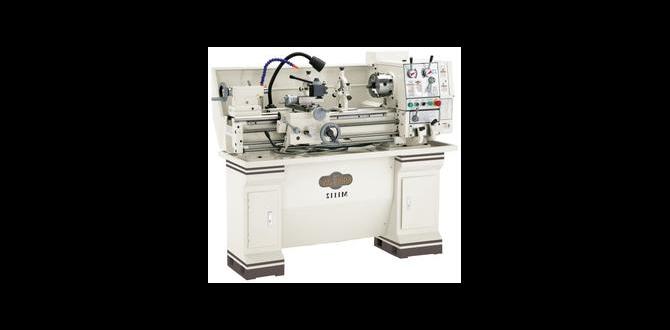A 1/8 inch carbide end mill with a 1/4 inch shank is a small but mighty tool, crucial for precise cutting and shaping in carbon steel. It excels at detailed work, slotting, and profiling on your milling machine, offering superior hardness and heat resistance compared to other materials, making it ideal for demanding carbon steel applications.
Working with carbon steel can feel a bit daunting when you’re just starting out. You might have the perfect project planned, but choosing the right cutting tool is key to getting clean, accurate results without a struggle. One tool that often comes up, especially for intricate work, is the 1/8 inch carbide end mill. It might seem small, but don’t let its size fool you! This little powerhouse is often essential for getting those precise cuts and details just right in tougher materials like carbon steel. If you’ve been wondering why this specific tool is so hyped up, or if you’re not sure when or how to use it effectively, you’re in the right place. We’re going to break down exactly what makes a 1/8 inch carbide end mill so special for carbon steel and how you can start using it with confidence in your own workshop.
Why a 1/8 Inch Carbide End Mill is Your Best Friend for Carbon Steel
When it comes to machining carbon steel, especially for detailed work, a 1/8 inch carbide end mill isn’t just an option – it’s often a necessity. Think of it as a precision scalpel for your milling machine. The “carbide” part is super important. Carbide is an incredibly hard material, much harder than the High-Speed Steel (HSS) often used for other cutting tools. This hardness means it can cut through tough stuff like carbon steel without getting dull quickly. Plus, it can handle much higher cutting speeds and temperatures. The “1/8 inch” refers to its cutting diameter, making it perfect for creating small slots, fine details, or intricate shapes that larger tools just can’t manage.
For carbon steel, the benefits are even more pronounced. Carbon steel is known for its strength and durability, but this also means it can be abrasive and tough on cutting tools. A standard HSS end mill might wear down fast, leading to poor cut quality and a lot of frustration. A carbide end mill, however, stays sharp longer, meaning more consistent results and less time spent changing tools. It also allows you to cut faster, which can significantly speed up your machining process. When you need to make precise grooves, engrave details, or mill out small pockets in a carbon steel workpiece, a 1/8 inch carbide end mill is the go-to tool for the job.
Understanding the “1/4 Inch Shank” Feature
You’ll often see this tool described as having a “1/4 inch shank.” This refers to the diameter of the part of the end mill that grips into your milling machine’s collet or tool holder. A 1/4 inch shank is a common size and works well with many beginner-friendly milling machines and common collet sets. It’s important that the shank size matches your machine’s tooling capabilities. A sturdy connection ensures minimal runout – that’s the wobble or deviation from a perfect rotation – which is absolutely critical for accuracy, especially with a small diameter end mill like this. Low runout means a cleaner cut and a more precise finished part.
What is “Stub Length”?
Sometimes you’ll see “stub length” mentioned for these end mills. This simply means the overall length of the cutting portion of the end mill is shorter than a standard length end mill of the same diameter. For a 1/8 inch end mill, a stub length version might have a cutting flute length of around 1/4 inch to 3/8 inch. Why is this good for carbon steel? A shorter flute length generally means a more rigid tool. Rigidity is key when cutting hard materials like carbon steel because it helps prevent chatter (vibration) and deflection (bending), leading to much cleaner cuts and a longer tool life. For small diameter tools like a 1/8 inch end mill, this extra rigidity from a stub length design is a big advantage.
Key Features of a 1/8 Inch Carbide End Mill for Carbon Steel
When you’re looking to buy a 1/8 inch carbide end mill specifically for carbon steel, there are a few features that really stand out and make a difference. These aren’t just fancy terms; they directly impact how well the tool performs and how long it lasts.
1. Material: Carbide is King
As we’ve touched on, the material is paramount. Carbide, often tungsten carbide, is a composite material known for its extreme hardness and wear resistance. This is exactly what you need when milling carbon steel. Unlike High-Speed Steel (HSS), carbide can maintain its cutting edge at much higher temperatures, which are generated during the cutting process. This means you can cut faster, take heavier cuts (within reason for a small end mill), and achieve a much longer tool life before needing to sharpen or replace it.
2. Geometry: Flute Count and Design
The number of flutes (the spiral cutting edges) on an end mill affects its performance. For carbon steel and with a small diameter like 1/8 inch:
- 2-Flute End Mills: These are excellent for slotting and general-purpose milling in softer metals and plastics. For harder metals like carbon steel, a 2-flute design offers good chip evacuation, which is crucial to prevent the tool from overheating and to keep the cut clean. They have more cutting edge clearance, allowing them to handle tougher materials with less clogging.
- 3-Flute and 4-Flute End Mills: While more flutes mean a smoother finish and better rigidity in softer materials, they can sometimes lead to chip packing in harder materials like carbon steel, especially in small diameters. For 1/8 inch carbide end mills in carbon steel, 2-flute or sometimes 3-flute are often preferred. The priority is efficient chip removal to manage heat and prevent binding.
The helix angle (the steepness of the spiral flute) also matters. A steeper helix angle can lead to a more aggressive cut and better chip evacuation, which is beneficial for carbon steel.
3. Coatings: An Extra Layer of Defense
Some carbide end mills come with specialized coatings. These coatings add an extra layer of hardness, reduce friction, and improve heat resistance. For milling carbon steel, coatings like:
- Titanium Nitride (TiN): A common, cost-effective coating that adds hardness and offers some heat resistance.
- Aluminum Titanium Nitride (AlTiN) or Titanium Aluminum Nitride (TiAlN): These are excellent for high-temperature applications and provide superior performance when machining steels and other hard materials. They are ideal for carbon steel.
- Zirconium Nitride (ZrN): Offers good lubricity and wear resistance.
A coated end mill will generally last longer and perform better on carbon steel than an uncoated one.
4. Shank and Overall Rigidity
A 1/4 inch shank, especially on a stub length tool, provides a good balance of rigidity and compatibility with common milling setups. The idea is to minimize any flex or vibration. A solid connection to your machine is vital. When dealing with a small diameter tool, any wobble (runout) will be magnified, leading to poor surface finish and potential tool breakage. Using a high-quality collet and ensuring it’s clean and properly seated is as important as the end mill itself.
How to Use Your 1/8 Inch Carbide End Mill on Carbon Steel: A Step-by-Step Guide
Using a small but powerful tool like a 1/8 inch carbide end mill on carbon steel requires a bit of care and precision. But don’t worry, with these steps, you’ll be cutting with confidence. We’ll cover everything from setup to making the cut.
Step 1: Prepare Your Workpiece and Machine
Secure the Workpiece: This is the most critical safety step. Your carbon steel workpiece must be held incredibly firmly. Use a milling vise with smooth, parallel jaws. Place parallels under your workpiece if needed to raise it to the correct height for the end mill. Ensure the vise is tightened down securely. Loose workpieces are dangerous and will lead to ruined parts. Ensure your machine is clean and free of debris.
Mount the End Mill: Select a clean collet that precisely matches your 1/8 inch end mill shank. Clean the collet and the collet nut threads. Insert the end mill into the collet, ensuring it’s seated fully. Tighten the collet nut securely using the appropriate wrench. Ensure very little of the end mill’s shank is sticking out past the collet – just enough to make the cut. This enhances rigidity.
Set Your Spindle Speed (RPM): This is crucial! Carbide mills can run faster than HSS, but the exact speed depends on your machine’s capabilities, the specific grade of carbide, and the type of carbon steel you’re cutting. A good starting point for a 1/8 inch carbide end mill in mild carbon steel might be around 5,000 to 15,000 RPM. However, always consult the end mill manufacturer’s recommendations if available. For beginner work, start conservatively. You can always increase speed if the cut is too slow and the tool isn’t complaining.
Step 2: Setting Up the Cut
Plunge or Side Milling?: A 1/8 inch end mill is generally not designed for deep plunging into solid material. For starting a slot or pocket, you’ll typically want to “ramp in” or “plunge” gently. If you must plunge straight down, do it slowly and at a reduced feed rate. Side milling, where the end mill moves across the surface of the material, is its primary function.
Determine Feed Rate: The feed rate is how quickly the tool advances into or through the material. This is just as important as RPM. Too fast, and you’ll break the tool. Too slow, and you’ll rub, generate excessive heat, and dull the tool quickly. For a 1/8 inch carbide end mill in carbon steel, start with a conservative feed rate. A general guideline might be 0.001 to 0.002 inches per tooth (IPT). With a 2-flute end mill, this translates to a federate of 0.002 to 0.004 inches per minute (IPM). Always use the slowest setting on your machine or manual control to start.
Chip Load: This is the thickness of the chip being removed by each cutting edge. Getting the chip load right ensures efficient cutting and prevents overheating. A stub length with a solid flute design will help achieve optimal chip load. For carbon steel, you want chips that are thin and cleanly removed, not dust or gummy build-up.
Step 3: Making the Cut
Lubrication/Coolant: Machining carbon steel generates heat. Using a cutting fluid or coolant is highly recommended. It lubricates the cut, cools the tool and workpiece, and helps wash away chips. For small-scale work, a good spray of cutting fluid or even a light oil can make a huge difference. Ensure the coolant reaches the cutting zone.
Depth of Cut: For a 1/8 inch end mill, especially in carbon steel, you should take light passes. The radial depth of cut (how far across the material you’re cutting) and the axial depth of cut (how deep you’re cutting vertically) should be conservative. A common rule of thumb for roughing is to take a radial depth of cut no more than 50% of the end mill diameter. For finishing, aim for much less. For axial depth, start with a shallow pass, perhaps 1/8 inch (0.125 inches) or less, especially if slotting. You can always go deeper in multiple passes.
Feed and Speed Control: Once you start cutting, monitor the sound and feel of the machine. A smooth, consistent sound usually means you’re cutting well. If you hear squealing or chattering, adjust your speed or feed rate. If the tool is rubbing and not cutting, increase your feed rate slightly or decrease your spindle speed. Always make adjustments incrementally.
Step 4: Finishing Touches and Best Practices
Multiple Passes: It’s almost always better to make multiple shallow passes than one deep pass. This reduces stress on the tool and machine, improves surface finish, and lowers the risk of breakage. For example, to cut a 1/4 inch deep slot, you might make two 1/8 inch deep passes.
Finishing Pass: For a critical dimension or a smooth surface, consider taking a final “clean-up” or “finishing” pass. This is a very light cut (e.g., 0.002 to 0.005 inches deep) taken at a slightly slower feed rate. This can remove any minor imperfections left by earlier passes.
Chip Evacuation: Regularly check for chip buildup. If chips are packing around the cutting edges, particularly on through cuts or in deep pockets, you may need to adjust your feed rate, spindle speed, or use an air blast to clear them. Good chip evacuation is vital for cooling and preventing tool failure.
Tool Inspection: After each significant use, inspect your end mill. Look for signs of wear, chipping, or dulling on the cutting edges. A dull end mill will cause increased heat, poor surface finish, and can lead to tool breakage. Keep your tools sharp and in good condition.
When to Choose a 1/8 Inch Carbide End Mill: Applications
The small size and extreme hardness of a 1/8 inch carbide end mill make it perfect for a range of specialized tasks, especially when working with carbon steel. Here are some common applications where this tool truly shines:
- Detailed Engraving and Lettering: When you need to engrave serial numbers, logos, or intricate designs into a metal part, this small end mill is the ideal choice. Its precision allows for crisp, clear lines.
- Creating Small Slots and Grooves: For tight tolerances or small mechanisms, machining precise slots or keyways that are only 1/8 inch wide is a perfect job for this end mill.
- Pocketing and Cavity Milling: When a design calls for small, intricate pockets or recesses in a metal part, this tool can carefully mill out the material to the exact shape required.
- Profiling and Contouring Small Parts: If you’re giving a small metal workpiece a specific outline or contour, a 1/8 inch end mill can follow complex paths with high accuracy.
- Deburring Small Features: It can be used to lightly deburr or chamfer very small internal edges where a larger tool wouldn’t fit.
- Machining Prototypes and Fixtures: For creating detailed components in prototypes or precise fixtures, the accuracy offered by this tool is invaluable.
- Working in Tight Spaces: Its compact size means it can access areas that larger tools simply cannot reach.
The key takeaway is precision. Whenever your project demands small, intricate features, fine details, or tight tolerances in carbon steel, the 1/8 inch carbide end mill is likely the tool you need for the job. It’s about achieving a level of detail that’s simply not possible with larger tools.
Comparison: Carbide vs. HSS for 1/8 Inch End Mills in Carbon Steel
When selecting a tool for milling carbon steel, especially a small one like a 1/8 inch end mill, the choice between Carbide and High-Speed Steel (HSS) is significant. Understanding their differences will help you make the best decision for your project and workshop.
Here’s a breakdown:
| Feature | 1/8 Inch Carbide End Mill | 1/8 Inch HSS End Mill |
|---|---|---|
| Hardness | Extremely high. Resists wear and deformation at high temperatures. | Good, but significantly less hard than carbide. Can soften at high temperatures. |
| Heat Resistance | Excellent. Can withstand much higher cutting temperatures. | Moderate. Heat buildup can quickly lead to softening and dulling. |
| Cutting Speed | Can run at significantly higher RPMs and faster feed rates. | Requires much lower RPMs and slower feed rates to avoid overheating. |
| Tool Life | Generally much longer, especially in hard materials like carbon steel. | Shorter tool life, particularly when cutting carbon steel consistently. |
| Brittleness | More brittle. Can chip or shatter if subjected to shock or heavy side loads. | More ductile and less prone to catastrophic failure from minor shocks. |
| Cost | Higher initial purchase price. | Lower initial purchase price. |
| Chipping Risk | Higher risk of chipping if feeds/speeds are incorrect or if runout is present. | Lower risk of chipping, but more prone to dulling. |
| Performance on Carbon Steel | Superior. Handles the hardness and abrasiveness of carbon steel much better. | Adequate for light use, but struggles with efficiency and tool life compared to carbide. |
For the specific task of milling carbon steel, a 1/8 inch carbide end mill is the clear winner for performance, longevity, and efficiency. While HSS is cheaper and more forgiving of minor errors, it will simply






